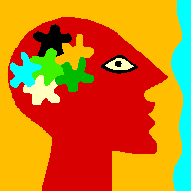
Abnormal psychology dates back to Egyptian and Mesopotamian cultures. These cultures saw mental abnormalities as a reflection of the presence of evil spirits or other supernatural powers. During this time, threphining was often used, which involves drilling a hole in a person's skull. This was viewed as a way to let evil spirits escape. Prayer and faith healing was often used to treat abnormal behaviors. One other common form of treatment used during this time was exorcism.
During the Classical Period, people began to believe that humans were capable of understanding and taking control of themselves and their world. Plato and Aristotle were two of the greatest philosophers of the time. Plato believed that humans gained knowledge of the world rationally, through reasoning and recollection. Aristotle claimed that people acquire knowledge through analyzing perceived events. The classical period also brought the medical model. Hippocrates argued that illnesses have natural, and physical causes and that mental disorders are biological in nature. Hippocrates concluded that mental disorders can be traced to imbalances among the four major fluids or humors of the body- yellow bile, black bile, blood, and phlegm. For example, they believed that excessive yellow bile would cause mania and too much black bile caused depression. Treatments consisted of efforts to restore balance among the four humors through diets, laxatives, and purgatives.
The European tradition swayed between supernatural and physical causes and their treatments consisted of magical and herbal treatments.
During the Middle Ages science became less important. Supernatural forces, especially the Devil, demons, and witches were responsible for disordered behavior. Disorders were treated with exorcisms and other religious rituals.
The Renaissance brought the rise of humanism. People began to study individuals and human nature, including behaviors and social relations. They saw the body as a biological machine. Johann Weyer gave naturalistic explanations of mental disorders that included biological and psychological factors. He is often considered the first psychiatrist. Treatments during this time gradually took on the form of confinement in hospitals.
The Enlightenment period gave rise to science. People believed in human reason and science during this time. Phillipe Pinel began to instill moral treatment into patients once again. New mental hospitals were built, but were often understaffed, so care became inefficient once again. Mesmer also brought about the idea of hypnotism, which is still used today. Freud was the first to focus on unconscious processes and dreams.
Contemporary Approaches
5 Models
Biological Model- This model believes that the nervous system controls all thoughts and behavior-both normal and abnormal. Mental disorders are assumed to arrise from changes in neural functioning, triggered by traumatic life events, drugs, hormone imbalances, environmental toxins, head trauma, major infections, genetic defects, and other biological factors. Drugs are the most common treatment for this model.
Sociocultural Model- This model emphasizes external factors, such as harmful environments, cultural traditions, powerlessness, and so on. People's behavior is viewed in relation to the cultural environment.
Phenomenological Model- Human behavior is determined by each person's unique perception of the world rather than instincts, conflicts, or environmental consequences. Carl Roger's is one of the main proponents of this theory. He believed that people have an innate drive toward personal growth that he referred to as self-actualization. He saw all human behavior as a reflection of their attempts to reach self-actualization.
Psychodynamic theories- These theories follow the idea that all behavior is influenced by unconscious forces. Freud was the leader in this area of thought.
Behavioral Theories- The idea behind these theories is conditioning. One is operant conditioning, which states that behaviors followed by pleasurable outcomes are more likely to be repeated, while behaviors that lead to unpleasant effects are less likely to be repeated. Another behavioral theory of abnormality is classical conditioning. This theory is based on the idea that behavior is based on reflexes that were automatically elicited by the environment. This is demonstrated by Pavlov and his study with dogs. In this study he repeatedly paired an unconditioned stimulus such as food, which elicits an unconditioned response such as salivation, with a nuetral stimulus such as a tone. Therefore, the dogs learn to salivate in response to a tone.
This is a site created for ISSI470, an academic course at Monmouth College
